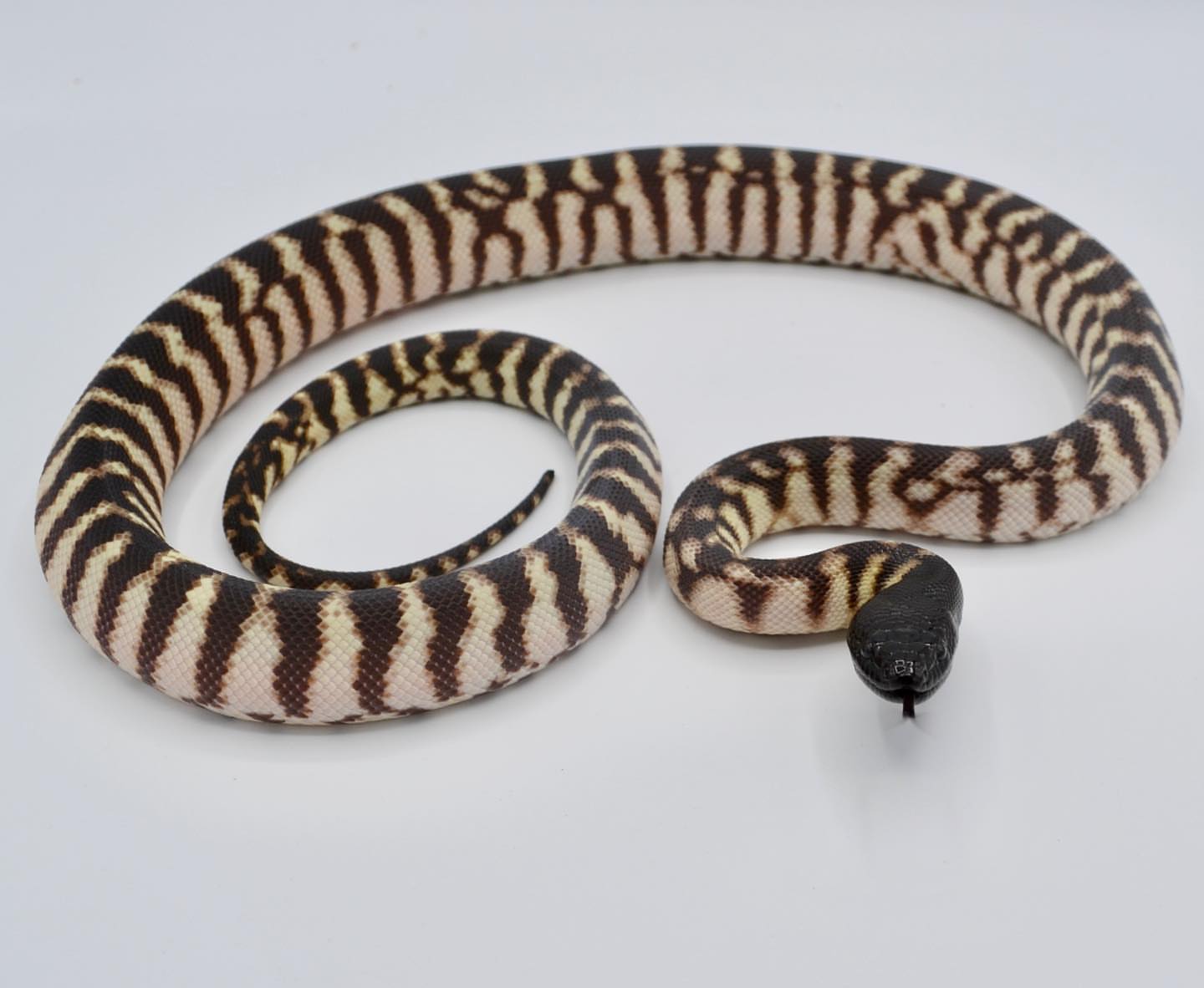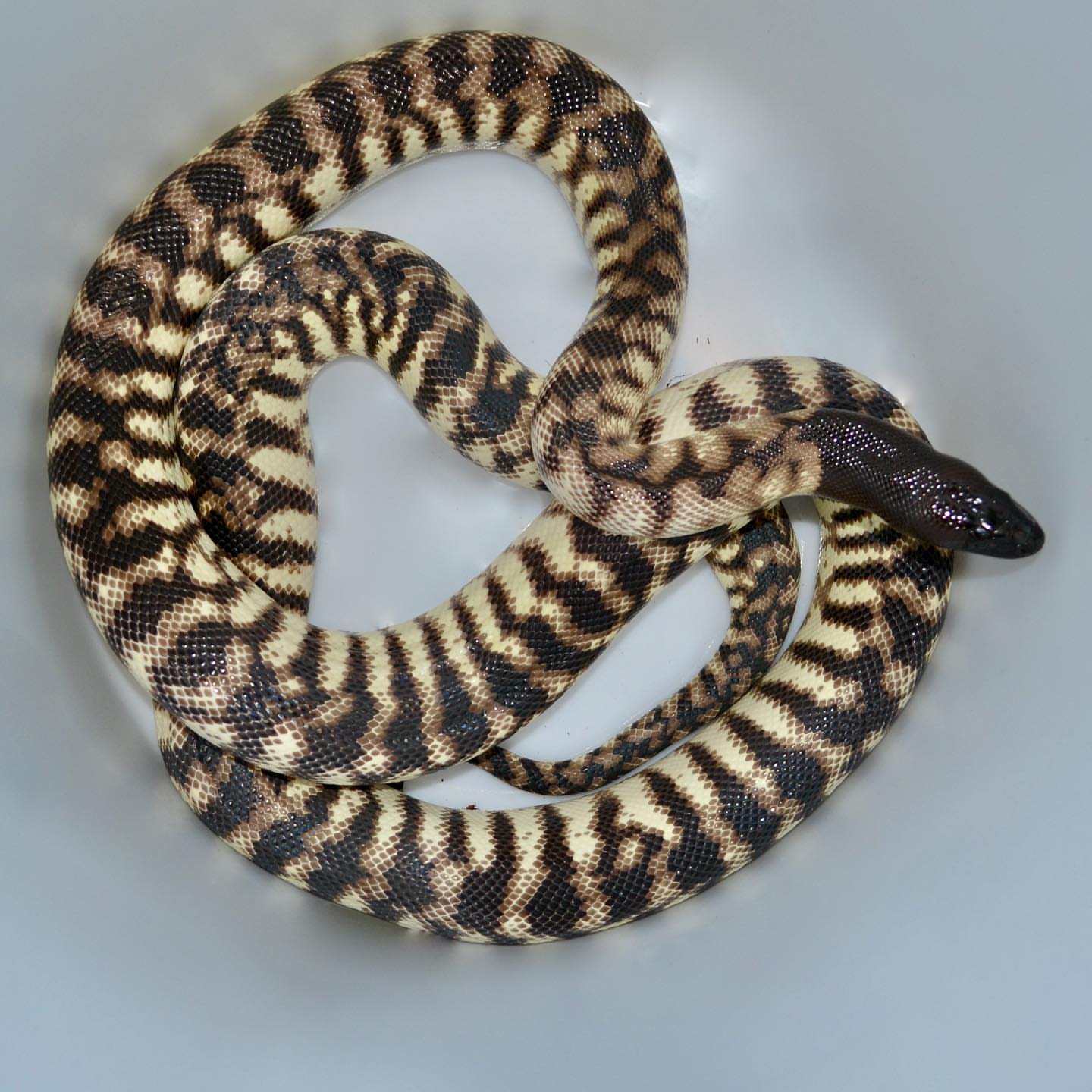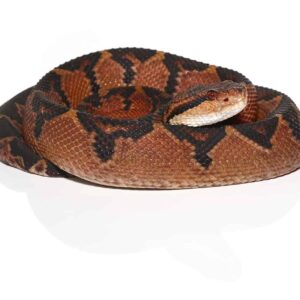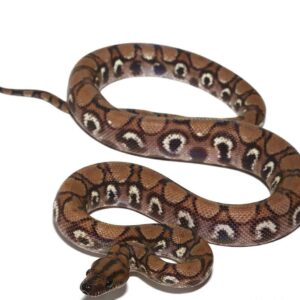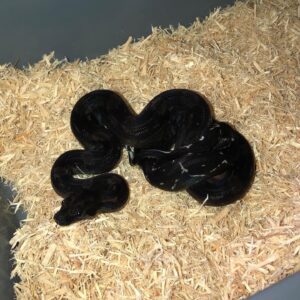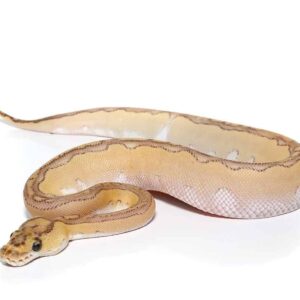Black Headed Python For Sale
$1,425.00
Black-headed Python ( Aspidites melanocephalus ) is a kind of non-venomous snake belonging to the Pythonidae (the Python family). As they are non-venomous, the snakes have to constrict their prey in order to kill the prey prior to consumption.
Habits and Lifestyle
Black headed python reside in the ground and are usually found in the sand and debris.
When disturbed, they yell loudly but aren’t likely to bite unless they are hunting for prey. Sometimes, they strike with their mouths closed however, they can generally be handled with ease. Pythons are strong swimmers, however they rarely spend much time in water.
To cool down, Black Headed Python bury their black head in sand.
Furthermore,
The black headed pythons stay in the dark and are solitary. Since they are in tropical regions, they get warmer faster and remain warmer for longer. This means that they’re able to consume more food since they digest food more quickly in warmer temperatures. When eating large prey, black headed python make one or two coils before their mouths, which are wide and, through constriction, help in swallowing the prey much easier.
Diet and nutrition
The black headed python is a carnivore. They eat primarily reptiles and snakes. However, they may also eat mammals when they are available.
DIET Carnivore
- Aesthetic Appeal: The Axanthic morph is visually distinctive, featuring a contrasting black and white coloration. This can make these pythons particularly appealing to reptile enthusiasts who appreciate the aesthetics of unique and visually striking snakes.
Hence,
- Rare and Unique: Axanthic Black-Headed Pythons are relatively rare, and their unique appearance sets them apart from more common color morphs. For those seeking a snake that stands out, the Axanthic Black-Headed Python can be an attractive choice.
- Breeding Projects: Breeders may be interested in Axanthic Black-Headed Pythons for their genetics. Breeding an Axanthic snake with other morphs can produce visually diverse offspring with various color patterns, contributing to the diversity of available captive-bred pythons.
- black headed python for sale
| black head python |
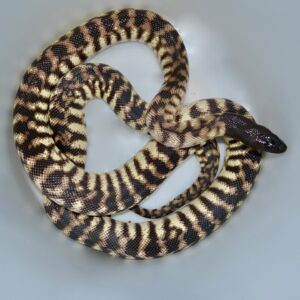
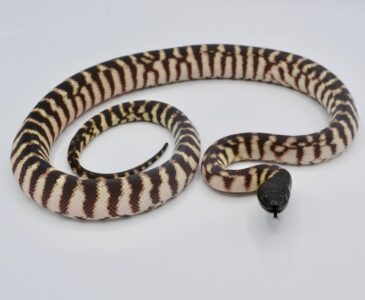
Description
The Black Headed Python, scientifically known as Aspidites melanocephalus, is a captivating species native to Australia. Predominantly found in northern regions such as Queensland, Northern Territory, and Western Australia, this python thrives in a variety of habitats ranging from arid scrublands to tropical forests. One of its most striking features, which also gives it its name, is its distinctive black head. This unique characteristic is in stark contrast to its lighter, often brown or cream-colored, body adorned with irregular banding or blotches.
Unlike many other snakes, the Black Headed Python is non-venomous, making it harmless to humans. Its diet primarily consists of reptiles, including other snakes, which it often preys upon by utilizing its constricting abilities. This python is known for its docile and reclusive nature, generally avoiding human contact and preferring to stay hidden during the day to escape the heat. Its nocturnal activities include hunting and exploring its environment.
In terms of size, the Black Headed Python can grow to an impressive length, typically ranging from 1.5 to 2 meters, though some individuals may reach up to 3 meters. Its robust body and smooth scales contribute to its sleek appearance, further enhancing its appeal among reptile enthusiasts and researchers alike. The combination of its distinctive black head and contrasting body colors makes the Black Headed Python a visually striking and fascinating species to study.
Overall, the Black Headed Python represents a unique member of the python family, with its non-venomous nature and intriguing behaviors. As we delve deeper into the fascinating world of this python, we will uncover more about its habitat, diet, and role in the ecosystem, shedding light on why it remains a subject of interest and admiration among herpetologists and wildlife aficionados.
Habitat and Distribution
The Black Headed Python, scientifically known as Aspidites melanocephalus, thrives in a variety of natural habitats across Australia. This species is particularly adaptable, often found inhabiting forests, woodlands, and scrublands. These environments provide the essential cover and food sources that are crucial for the survival of the Black Headed Python, offering a mix of dense vegetation and open spaces that facilitate hunting and shelter.
Geographically, the Black Headed Python’s distribution spans several significant regions in Australia. It is predominantly found in the Northern Territory, Western Australia, and Queensland. These areas are characterized by their diverse ecosystems, ranging from arid to semi-arid conditions, which the python has adeptly adapted to. In the Northern Territory, the species can be observed in the tropical savannas and grasslands, while in Western Australia, they are more commonly found in rocky outcrops and spinifex grasslands. In Queensland, its presence is noted in both coastal and inland regions, including eucalyptus forests and dry sclerophyll forests.
The environmental preferences of the Black Headed Python are indicative of its adaptability to various climatic conditions. However, it shows a particular inclination towards environments with moderate to high temperatures and specific humidity levels. Optimal temperature ranges for this species are typically between 25-35°C, aligning with the warm climatic conditions of its natural habitats. Additionally, humidity levels that fluctuate between 40-60% are favorable, ensuring the python’s physiological processes are well-regulated.
In essence, the Black Headed Python’s habitat and distribution reflect its remarkable ability to adapt to diverse environmental conditions. Its presence across numerous regions in Australia underscores its resilience and ecological significance, thriving in habitats that offer the right balance of temperature, humidity, and environmental complexity.
Physical Characteristics
The Black Headed Python (Aspidites melanocephalus) is a captivating species known for its distinctive physical attributes. This non-venomous snake can grow to an impressive length, with adults typically reaching up to 3 meters. The striking black coloration of the head is one of its most recognizable features, believed to play a crucial role in thermoregulation. By absorbing heat more efficiently, the black head aids the python in maintaining its body temperature, particularly in cooler environments.
Beyond its head, the Black Headed Python exhibits a unique coloration pattern that ranges from light brown to yellowish hues, often adorned with darker bands or mottling along its body. This coloration provides excellent camouflage in its natural habitat, aiding in both predation and evasion from potential threats. The scales of the Black Headed Python are smooth, giving it a sleek appearance and allowing it to move effortlessly through its surroundings.
In terms of body structure, the Black Headed Python is robust and muscular, designed for constriction. Its stout form is typical of pythons, enabling it to subdue prey effectively. The snake’s ventral scales, which run along the underside, are especially adapted for gripping and navigating various terrains, from rocky outcrops to loose soil.
Sexual dimorphism in the Black Headed Python is relatively subtle but can be observed upon closer inspection. Males are generally smaller and more slender compared to females, which tend to be larger and more robust, particularly when gravid with eggs. This size difference is thought to be linked to the reproductive roles of each gender, with females requiring more body mass to support the development of their offspring.
Overall, the Black Headed Python’s physical characteristics not only contribute to its survival and efficiency as a predator but also enhance its ability to adapt to diverse environmental conditions. Its unique appearance and functional attributes make it a subject of great interest within the herpetological community.
Behavior and Diet
The Black Headed Python exhibits a range of fascinating behaviors that are intricately tied to its survival and hunting strategies. This species is predominantly nocturnal, meaning it is most active during the night. This nocturnal nature allows the Black Headed Python to effectively hunt its prey under the cover of darkness, reducing the risk of predation and increasing its hunting success.
A hallmark of the Black Headed Python’s hunting technique is its use of ambush tactics. Rather than actively chasing its prey, this python prefers to lie in wait, often concealed within vegetation or burrows, until an unsuspecting animal comes within striking distance. This method of predation is energy-efficient and highly effective, as it allows the python to capture a variety of prey with minimal effort.
The diet of the Black Headed Python is primarily composed of reptiles, including other snakes, and small mammals. This dietary preference highlights the python’s role as an apex predator within its ecosystem. By consuming a wide range of reptiles, the Black Headed Python helps regulate the populations of these species, maintaining a balanced ecosystem.
In addition to its ambush tactics, the Black Headed Python exhibits unique behaviors such as burrowing and climbing. The python’s ability to burrow allows it to escape extreme temperatures and avoid predators, while climbing skills enable it to access prey that may be out of reach for ground-dwelling predators. These behaviors showcase the adaptability and versatility of the Black Headed Python in its natural habitat.
Overall, the behavior and diet of the Black Headed Python underscore its role as a skilled and adaptable predator. Its nocturnal and ambush hunting strategies, combined with a varied diet and unique behaviors, make it a fascinating subject of study for herpetologists and wildlife enthusiasts alike.
Reproduction and Lifespan
The reproductive cycle of the Black Headed Python (Aspidites melanocephalus) is a captivating process characterized by unique behaviors and stages. Mating typically occurs during the cooler months, from June to August. During this period, males engage in combat to win the opportunity to mate with a female. This ritual involves intertwining their bodies and attempting to pin each other down. Once a male has successfully courted a female, copulation ensues.
The gestation period for the Black Headed Python is approximately three to four months. Females lay eggs rather than giving live birth, a practice known as oviparity. Clutch sizes can vary, but on average, a female deposits between 5 to 15 eggs. The eggs are laid in a secure, warm environment such as beneath leaf litter or in a burrow, where they are left to incubate. The incubation period ranges from 50 to 60 days, influenced by the ambient temperature and humidity levels.
Interestingly, the Black Headed Python exhibits minimal parental care. After laying the eggs, the female does not remain to guard or incubate them. Instead, the eggs are left to develop independently. Upon hatching, the young pythons are immediately self-sufficient, capable of hunting and fending for themselves without any parental assistance.
The lifespan of the Black Headed Python varies between wild and captive environments. In the wild, these pythons generally live between 10 to 15 years, facing natural predators and environmental challenges that can influence their longevity. Conversely, in captivity, where they are safeguarded from predators and provided with consistent care, Black Headed Pythons can live up to 20 to 25 years. This extended lifespan in captivity underscores the importance of a stable and controlled environment in promoting the well-being of these fascinating reptiles.
In summary, the reproductive behaviors and lifespan of the Black Headed Python highlight the species’ adaptability and resilience. From their unique mating rituals to their independent hatchlings, these pythons continue to intrigue herpetologists and reptile enthusiasts alike.
Conservation Status
The Black Headed Python (Aspidites melanocephalus) is currently listed as “Least Concern” on the International Union for Conservation of Nature (IUCN) Red List. This classification indicates that the species is relatively stable and not facing an immediate threat of extinction. However, it is crucial to recognize that certain factors could jeopardize this status if not adequately addressed.
Habitat destruction poses a significant threat to the Black Headed Python. As human activities expand, the natural habitats of these pythons are increasingly encroached upon, leading to habitat fragmentation and loss. Deforestation for agricultural development and urbanization are primary drivers of this environmental change. The reduction of suitable living spaces can result in decreased population densities and genetic diversity, which are critical for the long-term survival of the species.
Climate change is another emerging concern. Alterations in temperature and precipitation patterns can disrupt the delicate balance of the ecosystems where these pythons thrive. Additionally, changes in climate can affect the availability of prey species, further impacting the snake’s ability to sustain its population.
Moreover, the illegal pet trade also poses a threat to the Black Headed Python. These snakes are often sought after for their distinctive appearance, making them a target for wildlife traffickers. The removal of individuals from their natural habitat for sale as exotic pets can lead to local population declines and disrupt the ecological balance.
To mitigate these threats, various conservation efforts are underway. Protected areas and wildlife reserves play a vital role in safeguarding the natural habitats of the Black Headed Python. Conservation organizations are also working to raise awareness about the importance of preserving this species and its environment. Legal protections, such as regulations on the trade of wildlife, aim to reduce the impact of the illegal pet trade. Collaborative efforts involving governments, NGOs, and local communities are essential to ensure the continued survival of the Black Headed Python.
Interaction with Humans
The relationship between the Black Headed Python (Aspidites melanocephalus) and humans is multifaceted, encompassing various aspects such as the pet trade, cultural significance, and the responsibilities that come with keeping one as a pet. This species is often sought after in the exotic pet market due to its distinctive appearance and relatively docile nature. However, owning a Black Headed Python requires a deep understanding of its needs and a commitment to providing appropriate care.
In the pet trade, the Black Headed Python is prized for its striking black head and banded body, which makes it a unique addition to any collection. Potential owners should be aware that these pythons can grow up to 2.5 meters (over 8 feet) and require spacious enclosures, controlled temperature, and humidity levels to thrive. Feeding them a diet primarily consisting of rodents, maintaining regular health check-ups, and ensuring a clean habitat are crucial responsibilities. Neglecting these needs can lead to health issues and stress for the snake.
Beyond the pet trade, the Black Headed Python holds cultural significance in some indigenous Australian communities. It is often featured in local folklore and traditional stories, symbolizing various aspects of nature and life. These cultural connections highlight the importance of respecting the species and its natural habitat, reinforcing the need for conservation efforts.
While generally non-venomous and not aggressive towards humans, there are potential risks associated with handling Black Headed Pythons. They possess strong muscles and can deliver a painful bite if threatened or mishandled. It is essential for owners and handlers to be properly educated on how to interact with these pythons safely and respectfully.
On the other hand, the interaction between humans and Black Headed Pythons can also be beneficial. Educating the public about this species can foster a greater appreciation for wildlife and promote conservation efforts. Additionally, responsible pet ownership can contribute to the well-being and preservation of these remarkable reptiles.
Interesting Facts and Myths
The Black Headed Python, scientifically known as Aspidites melanocephalus, is a captivating species native to Australia. One of the most striking features of this reptile is its distinct black head, which serves a unique functional purpose. The dark pigmentation helps the python to absorb heat more efficiently, allowing it to regulate its body temperature effectively. This adaptation is particularly beneficial in the varied and often harsh climates of its native habitat.
Contrary to popular belief, the Black Headed Python is a non-venomous snake. This species relies on constriction to subdue its prey, which typically includes small mammals, birds, and reptiles. Despite its imposing appearance, this python is generally docile and exhibits low aggression levels towards humans. Many myths surrounding the Black Headed Python, such as it being aggressive or venomous, are unfounded and can be attributed to general misconceptions about snakes.
Behaviorally, the Black Headed Python is known for its nocturnal and crepuscular activity patterns. It is most active during the cooler parts of the day, such as early morning or late evening. This snake is also known for its burrowing habits, often found in termite mounds or beneath debris, which offers both protection and a stable micro-environment.
Another intriguing aspect of the Black Headed Python is its reproductive strategy. Females lay clutches of up to 20 eggs, which they incubate by coiling around them to maintain a consistent temperature. This maternal behavior is quite fascinating and showcases the species’ unique adaptation strategies for ensuring the survival of their offspring.
In terms of lesser-known trivia, the Black Headed Python has a remarkable ability to consume prey larger than its head due to its highly flexible jaw structure. This physiological trait allows it to exploit a wider range of food sources, contributing to its adaptability and success as a species.
By debunking common myths and highlighting these unique characteristics, we gain a deeper appreciation for the Black Headed Python, an extraordinary reptile that continues to intrigue herpetologists and enthusiasts alike.

